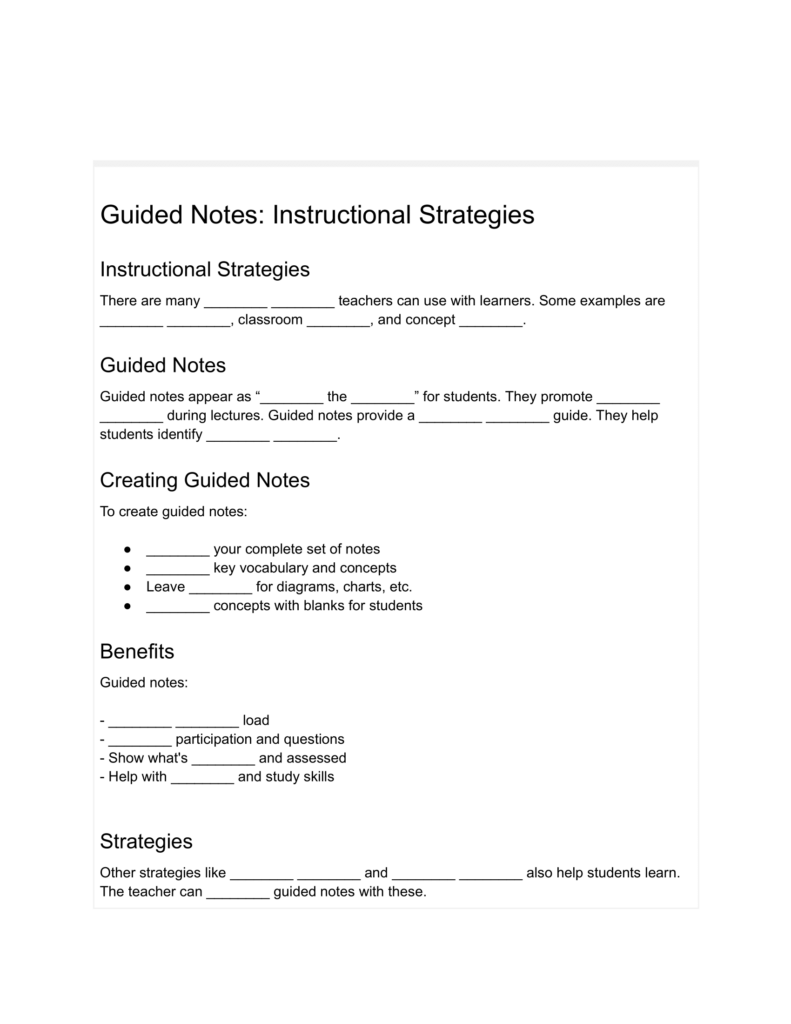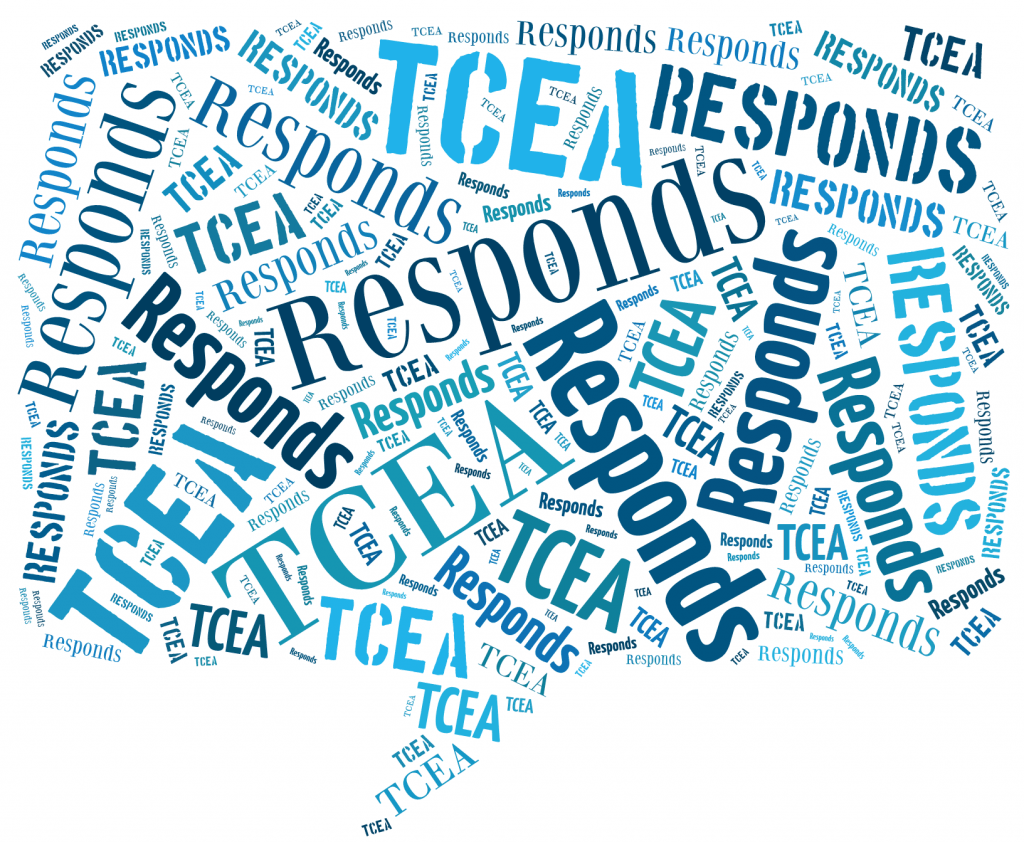Dear TCEA Responds:
I don’t understand guided notes. It’s like fill in the blank notes with the answers given. Are there some digital tools that can help me make guided notes? I teach emergent language learners.
-Mario
What are guided notes?
Thanks so much for your question. As you mention, guided notes appear as “fill in the blank” to students. They offer students certain information on the content and require them to fill in information during learning. And, you can pair research-based instructional strategies like these with them:
The Teacher Toolkit describes them in this way (adapted for readability):
Guided Notes are teacher-prepared handouts. They outline lectures, audiovisual presentations, or readings. The teacher leaves blank space for students to fill in key concepts, facts, etc.
Guided Notes promote active engagement during lecture or independent reading. They provide full and accurate notes for use as a study guide. Guided Notes also help students to identify the most important information covered
Let’s explore guided notes a bit more. From my perspective as an ESL teacher, they are a type of cloze activity. For fun, keep this printable document handy. You can take notes on it as you read this article!

What instructional strategy is behind guided notes?
Wondering which key instructional strategy is behind guided notes? The answer is Outlining and Summarizing, which enjoys an effect size of 0.62. The Visible Learning Meta X database describes this strategy as one that:
Involves identifying the main ideas and rendering them in one’s own words. The core skill is being able to distinguish between the main ideas and the supporting ideas.
ELLs and Guided Notes
Emerging language learners face many challenges when note-taking, among them:
- Grammar and spelling mistakes
- Use of abbreviations
- Disorganization
- Inability to connect or interpret new information to existing knowledge (source)
Teachers rely on guided notes when language learners need to:
- Focus on vocabulary and concept comprehension, rather than grammar and structure
- Process new information
- Write well in the target language under the pressure of time
- Identify main ideas and supporting details
Let’s take a closer look at this strategy you can use with your students.
Digging Into the Research
A 2020 review of guided notes instructional strategy research reveals the following salient points about guided notes and student learning.
Point #1: There are a variety of formats.
Formats include:
- Google Docs with partially-completed outlines
- fill-in-the-blank outlines on printed PowerPoint slides
- Paper versions of partially completed outlines
- Partially completed PowerPoint slides
- Notes with metacognitive guidance
Point #2: Improve Engagement
Researchers have found that students with guided notes participated more in class and supported student achievement. Student brains are engaged when actively constructing knowledge. Guided notes promote generative learning because they enable students to “focus more of their cognitive energy on higher-order thinking and learning.” Guided notes also address potential issues with students’ imperfect note-taking strategies.
Point #3: Positively Impact Quiz Scores
Several studies show that guided notes incorporating diagrams, pictures, blanks, spaces, and tables had more impact than plain note-taking. Positive effects were shown and resulted in quizzes with 10% higher scores. What’s more, 36% more accurate notes were taken with guided notes.
Students reported that they preferred guided notes to the alternative (no notes or taking notes themselves). Students “outperformed” those without guided notes. Students with “graphic organizers outperformed students with guided notes or no notes.”
An overview of the benefits:
- Reduces cognitive load on students
- Increases participation since students are more likely to ask questions and participate in class discussions
- Provides transparency as to what is important and to be assessed
- Facilitates note-taking and study skills for students (source)
How to Create Guided Notes
A daunting aspect of creating guided notes? You have to know what you are going to be covering in a presentation. Some suggestions:
- Create your set of complete notes.
- Review your notes and underline/highlight key vocabulary and concepts.
- Leave space for diagrams, concept maps, tables, and charts.
- Replace the vocabulary and concepts with blanks for students to fill in.
Before you expect students to use guided notes in the classroom, make sure to model their use first. You can find several video tutorials and template sites for creating guided notes with Google tools. Here’s one way to do it with tables in Google Docs.
John Sowash shares his approach to creating guided notes with Google Docs:
Here’s another walkthrough from Jan Parker for Google Slides:
Engaging Learners with Guided Notes
While guided notes represent a time investment up front for you as the teacher, they also ensure you and your students know what’s valued – that is, what important information will be shared, and what will be assessed. Since writing by hand engages students’ brains, then it is a worthwhile activity. Give it a try!
Bonus: Using AI
Another fun approach you can take is to rely on Claude.ai or ChatGPT 3.5 (both free) to create your guided notes. Keep your selections for guided notes short and to the point. Claude.ai allows you to attach a file in text or PDF so you don’t have to paste the content directly into the chat box. Type up your prompt, then attach the file with your outline or content.
Sample Prompt: Create guided notes for the following text:
Double Bonus: Digital Tools
Digital Tool #1: Hot Potatoes
Check out the free, download, Hot Potatoes. It makes it easy to create a variety of activities on MS Windows computers.
Digital Tool #2: Cloze Test Online
Create a cloze passage with this free, web-based tool. You copy and paste your content in, and it allows you to create a cloze passage.
Digital Tool #3: Guided-Notes Maker
With this digital tool, the creation of blank spaces is easy. Highlight one or more words and each selection appears in a red box. Learn more about this online.
Digital Tool #4: Knowt.io
You can use Knowt to create guided notes (as well as a lot of other items). Give it a spin. Read how you can use Knowt in other ways.
Want to learn more?
Sign up now for TCEA Lunch and Learn: Outlining and Summarizing event on September 6. Outlining and Summarizing involves identifying the main ideas and rendering them in one’s own words. Come along and learn a few ways you can use these two powerful instructional strategies with students. Did you miss it? No worries, find a recording in the TCEA Community.


